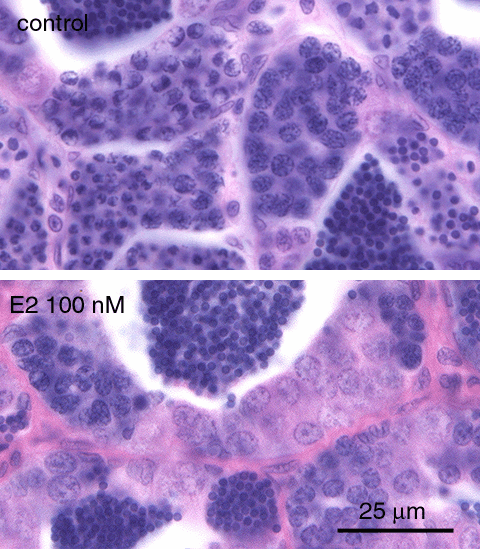
adult male zebrafish - upper image, reference; lower image, 100 nM E2, 3w After exposure of adult zebrafish to 17β-estradiol (E2) for three weeks, the most striking effect in the testis is a shift in size and ratio of the main spermatogonic classes, i.e. there are more and possibly larger cysts of spermatogonia
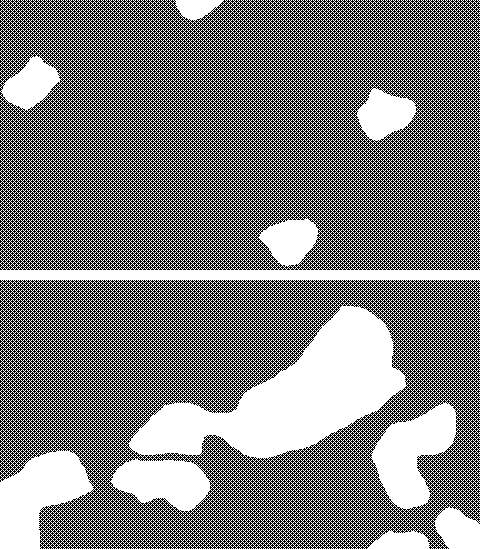 , and less and smaller spermatocyte cysts
, and less and smaller spermatocyte cysts and spermatid cysts
and spermatid cysts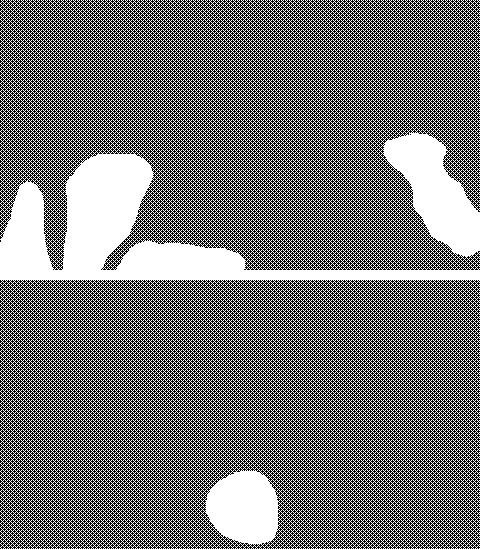 . Morphometrical analysis shows that this is due to inhibition of proliferation of spermatogonia (see bar graph below).
. Morphometrical analysis shows that this is due to inhibition of proliferation of spermatogonia (see bar graph below). Nevertheless, the lumen of the testis tubule is normally filled with mature sperm, but this may be explained by the short exposure time in relation to the duration time of the spermatogenic renewal cycle.
Another effect is that the interstitial compartment shows more prominent
 . On close examination, this seems mainly the result of accumulation of proteinaceous intra- and extravascular fluid. This protein is overproduction of vitellogenin, as indicated by immunohistochemistry and the basophilic staining of hepatocytes (see quantification of vitellogenin induction).
. On close examination, this seems mainly the result of accumulation of proteinaceous intra- and extravascular fluid. This protein is overproduction of vitellogenin, as indicated by immunohistochemistry and the basophilic staining of hepatocytes (see quantification of vitellogenin induction).
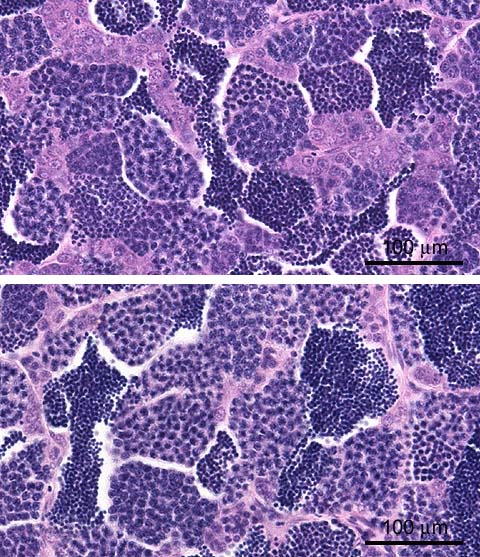
adult male F1zebrafish - upper image, control; lower image, 0.5 ng/L EE2, F0+F1 Lifetime exposure of F0 and F1 zebrafish to a low concentration of ethynylestradiol (EE2; 0.5 ng/L, equivalent to 0.0017 nM) produced a different effect in the testis. The testes of low exposure groups (lower image) showed larger spermatocytic cysts
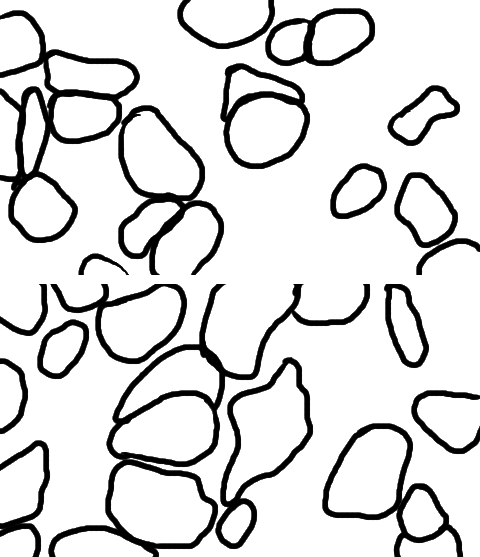 and smaller aggregates of spermatogonia
and smaller aggregates of spermatogonia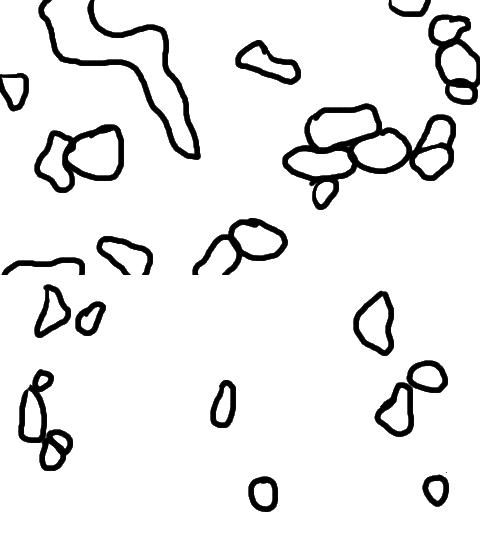 , compared to control (upper image), and also after a tenfold higher concentration when discontinued in F1 at 50 dpf.
, compared to control (upper image), and also after a tenfold higher concentration when discontinued in F1 at 50 dpf.
This suggests a shifted balance between proliferation and differentiation/maturation in these groups. Testes in these two exposed groups were possibly also larger than in controls.
There were no obvious differences in spermatids
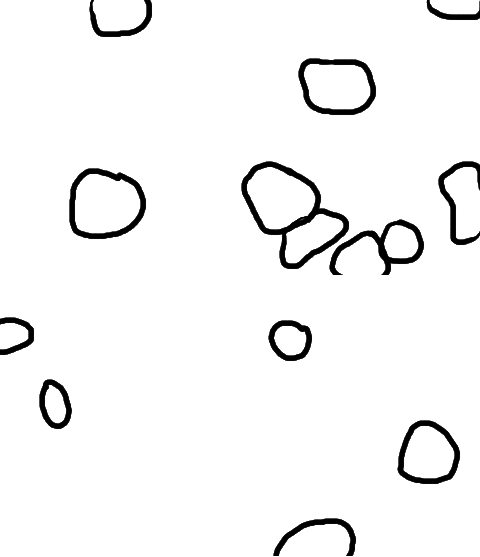 between groups.
between groups.
see also: effects in the ovary in this study.
see also: ovo-testis in this study.
Reference
- Nash JP, Kime DE, Van der Ven LT, Wester PW, Brion F, Maack G, Stahlschmidt-Allner P, Tyler CR. Long-term exposure to environmental concentrations of the pharmaceutical ethynylestradiol causes reproductive failure in fish. Environ Health Perspect.112:1725-1733; 2004.

Microscopical observation indicated a shift of spermatogenesis towards the spermatogonium stage after exposure to estrogen 17β-estradiol (E2) [see above]. This visual impression was verified by morphometrical analysis (see methods).
E2 induced a dose-dependent increase of the spermatogonium (sg) compartment
 , at the expense of the spermatocyte (sc) compartment
, at the expense of the spermatocyte (sc) compartment . The decrease of the spermatocyte area is explained by the decreased size and relative numbers of spermatocyte cysts
. The decrease of the spermatocyte area is explained by the decreased size and relative numbers of spermatocyte cysts . The decreased average size and decreased relative numbers of spermatocyte cysts (and also the smaller spermatid cyst size
. The decreased average size and decreased relative numbers of spermatocyte cysts (and also the smaller spermatid cyst size ) suggest disruption at the level of spermatogonium proliferation and maturation. The decreased area occupied by the progressed spermatogenic stages results in collaps of the testis and in a subsequent relative increase of spermatogonia in the field of view. Collaps of the testis after estrogenic exposure was confirmed by a decreased testis-somatic index in a study with ethynyl-estradiol1.
) suggest disruption at the level of spermatogonium proliferation and maturation. The decreased area occupied by the progressed spermatogenic stages results in collaps of the testis and in a subsequent relative increase of spermatogonia in the field of view. Collaps of the testis after estrogenic exposure was confirmed by a decreased testis-somatic index in a study with ethynyl-estradiol1.
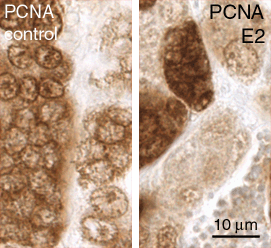
adult male zebrafish - left, reference; right,
100 nM E2, 3w; PCNA immunostaining (brown)
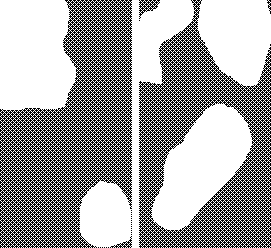 Thus, the main effect of E2 in the testis is probably inhibition of spermatogonium proliferation. This interpretation is supported by the reduced PNCA immunostaining in spermatogonium after estrogenic exposure
Thus, the main effect of E2 in the testis is probably inhibition of spermatogonium proliferation. This interpretation is supported by the reduced PNCA immunostaining in spermatogonium after estrogenic exposure .
.Morphomotrical comparison of effects of E2 and androgens is shown in the androgenic exposure section
Reference
- van den Belt-K, Wester-PW, van der Ven-LTM, Verheyen-R, and Witters-H. Time-dependent effects of ethynylestradiol on the reproductive physiology in zebrafish (Danio rerio). Environ. Toxicol. Chem. 21:767-75;2002.
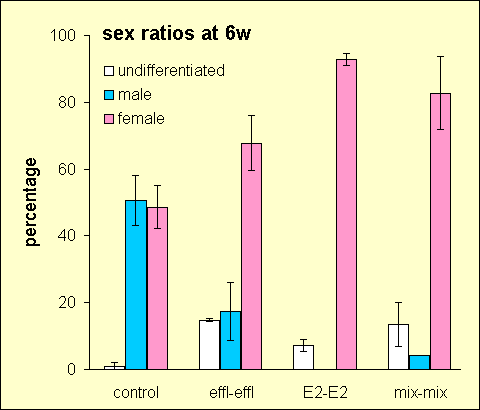
Distribution of sexes in the evaluation of the effects of effluent of a sewage treatment works (Eindhoven, the Netherlands) in zebrafish.
Zebrafish and subsequent hatched larvae / juveniles were not exposed (control) or exposed for 6 weeks to estradiol (E2), sewage effluent, or a synthetic mix analogous to the effluent composition.
Shown is the average of the percentages of the total number of animals in the respective groups (2-5 groups per treatment, 30-50 individuals per group) in each class.
It appeared that exposure of juveniles to either treatment inhibited testis development, compared to control animals, resulting in sex ratios favouring the female phenotype.